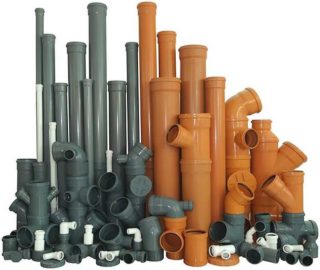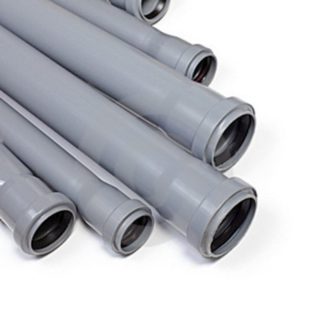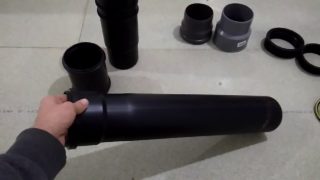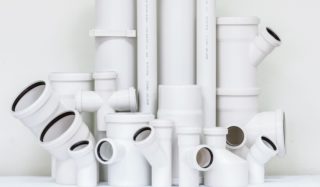Sewerage is a sanitary facility and a network of pipelines that collect human waste products, household and rainwater wastewater. It is part of the water supply and sewerage system of a modern city and village.
For any kind of sewage, sewer pipes are needed. The variety in color and texture also implies the presence of different characteristics for their application. Not a simple process of arranging a sewer system in a house or apartment. In order not to make mistakes, and then correct them, this process must be approached with full responsibility. Indeed, the entire sewerage system of the room, its effective performance, will envy from the correct choice of pipes.
Why are pipes of different colors
Manufacturers cannot paint pipes at their discretion, for this there are standards according to which production is carried out and these rules are mandatory for all companies involved in the production of these products.
If the sewer pipes do not fit into the interior of the room in color, then when choosing a suitable color scheme, it is necessary to thoroughly study the parameters of the product, perhaps they will not fit in other indicators. Only then make purchasing decisions. A wide variety enters into a stupor of the buyer, since he does not know the elementary purpose of this or that pipe.
Scope of application
- Internal sewerage wiring network.
- Sewer external wiring network.
- Treatment effluents.
The internal wiring network is used inside buildings, as a rule, it is brought to water intake devices: bathtubs, sinks, toilets, urinals, bidets, shower cabins - this is a system for collecting wastewater inside a building and delivering it to an external sewage system.
External sewerage wiring network - collection of wastewater from the building and discharge to treatment facilities or discharge into a water intake. The external sewage system can be central, from which the drains go to special treatment facilities or household, where a water purification collector can be located. There may also be a household pit, into which dirty water is dumped, and then, as it becomes full, it is pumped out by a sewer machine.
Sewage effluents - are used to collect storm water and quickly drain precipitation, as well as melt water or discharge water from technological enterprises. In special open-type ditches (irrigation ditches), water flows down and enters underground pipelines, and from there it can flow either to treatment facilities or directly to water bodies. Sometimes such water is discharged directly into uncrowded places, into forests, into plantings.
Pipe colors and scope
Due to the aggressiveness of the environment that carry wastewater through sewer pipes, serious requirements are imposed on them: the material of manufacture is cast iron, PE (polyethylene), PP (polypropylene), PVC (polyvinyl chloride), ceramic, asbestos-cement. All of them must be strong and durable, and each type of pipe has its own purpose. For, to facilitate the choice of manufacturers, they indicated sewer pipes in different colors.
Gray
The gray pipe is made of polyvinyl chloride, it is not afraid of corrosion, it is not heavy in weight, it is easy to install, it has a neutral color in terms of aesthetics. Pipes vary in size, but they have limitations in diameter.
Redheads
This type of pipe is intended for external sewerage, it is made of PVC (polyvinyl chloride), the diameter is 110, 125, 150 mm - the standard for such pipes. In length, they can be 500, 1000, 2000, 6000 mm in size. Large pipe sizes are designed to create sewage systems with a large flow area, storm sewers and culverts. The thickness of such a pipe is 3.2 mm. Such a pipe can be laid to a depth of 4 m. The temperature range is from -10 to + 60. A smooth pipe with a socket, according to the stiffness class SN 4, consists of several layers. It is ideal for outdoor sewerage.
The material from which the pipe is made is strong, durable, corrosion resistant and is not afraid of the effects of harmful microorganisms. Such a pipe has a smooth structure inside, which contributes to the passage of various drains without delay. Despite the rigidity and strength, it is not laid under the lines, since it will not withstand the pressure, will bend and cause blockage and subsequent breakdown. Although a ribbed surface and many layers gives an additional chance to withstand a large amount of soil.
This pipe is more expensive, but its service life is also high - about 50 years.
Black
Green
Such pipes are often made of cast iron, since this material is distinguished by its high strength and durability. There are pipes and plastic. The walls of such pipes are strong, designed to withstand a large layer of soil, and have perforations (drainage holes). Such products are used for underground drainage - they collect groundwater, withstand temperature extremes.
Blue
Blue pipes are often used to lay a rainwater and melt water drainage system inside heated residential and industrial buildings. These pipes are incredibly durable, as risers and drainpipes need to withstand the pressure of the water flow in the event of blockages and overflows in the system.
White
Temperature heating can withstand up to 950; when choosing such a pipe, you should not worry about its safety.Sound insulation at a height, the diameter of the pipe is varied in the range: from 32 mm to 150 mm. In length from 150 to 5000 mm. The thickness of the layer is about 2.7 mm and of course the pipe has a bell with a rubber ring, which makes the installation of the joint hermetically sealed. Various fittings and connections are easily selected for such pipes.
When it is known for what purposes a sewer pipe is needed, whether it be internal or external wiring, and the required diameter and size is known, it will not be difficult to assemble and bring the pipes, especially since no special tools and devices are required for this.













